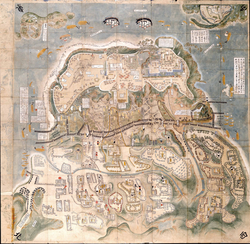
Back تمرد شيمبارا Arabic شیمابارا آیاقلانماسی AZB Rebel·lió de Shimabara Catalan Šimabarské povstání Czech Shimabara-Aufstand German Rebelión de Shimabara Spanish شورش شیمابارا Persian Shimabaran kapina Finnish Rébellion de Shimabara French מרד שימבארה HE
You can help expand this article with text translated from the corresponding article in Japanese. (April 2021) Click [show] for important translation instructions.
|
| Shimabara Rebellion | |||||||
|---|---|---|---|---|---|---|---|
| Part of the early Edo period | |||||||
 Shimabara battle map and Hara Castle | |||||||
| |||||||
| Belligerents | |||||||
|
|
| ||||||
| Commanders and leaders | |||||||
|
Amakusa Shirō Mori Sōiken † Arie Kenmotsu † Masuda Yoshitsugu † Ashizuga Chuemon † Yamada Emosaku | ||||||
| Strength | |||||||
| 200,000+[2] | 37,000–40,000[2] | ||||||
| Casualties and losses | |||||||
|
21,800 casualties
| 37,000+ killed[2] | ||||||
The Shimabara Rebellion (島原の乱, Shimabara no ran), also known as the Shimabara-Amakusa Rebellion (島原・天草の乱, Shimabara-Amakusa no ran) or Shimabara-Amakusa Ikki (島原・天草一揆), was an uprising that occurred in the Shimabara Domain of the Tokugawa shogunate in Japan from 17 December 1637 to 15 April 1638.
Matsukura Katsuie, the daimyō of the Shimabara Domain, enforced unpopular policies set by his father Matsukura Shigemasa that drastically raised taxes to construct the new Shimabara Castle and violently prohibited Christianity. In December 1637, an alliance of local rōnin and mostly Catholic peasants led by Amakusa Shirō rebelled against the Tokugawa shogunate due to discontent over Katsuie's policies. The Tokugawa shogunate sent a force of over 125,000 troops supported by the Dutch to suppress the rebels, which defeated them after a lengthy siege against their stronghold at Hara Castle in Minamishimabara.
Following the successful suppression of the rebellion, Shirō and an estimated 37,000 rebels and sympathizers were beheaded, and the Portuguese traders suspected of helping them were expelled from Japan. Katsuie was investigated for misruling, and was eventually beheaded in Edo, the only daimyō executed during the Edo period.[citation needed] The Shimabara Domain was given to Kōriki Tadafusa. Japan's policies of national seclusion and persecution of Christianity were tightened until the Bakumatsu in the 1850s.
Shimabara Rebellion is often portrayed as a Christian rebellion against violent suppression by Matsukura Katsuie. However the main academic understanding is that the rebellion was mainly by peasants against Matsukura's misgovernance, with Christians later joining the rebellion.[3]
The Shimabara Rebellion was the largest civil conflict in Japan during the Edo period, and was one of only a handful of instances of serious unrest during the relatively peaceful period of the Tokugawa shogunate's rule.[4]
- ^ Fairburn, William Armstrong (1945). Merchant Sail. Fairburn Marine Educational Foundation. ISBN 978-0-598-74741-9.
- ^ a b c d "WISHES". Uwosh.edu. 1999-02-05. Retrieved 2018-04-15.
- ^ "島原の乱 : 宗教一揆的要素の再評価". 史泉. 110: 36–55. 31 July 2009. hdl:10112/1067.
- ^ Borton, Japan's Modern Century, p. 18.